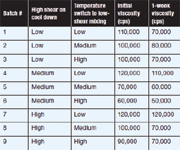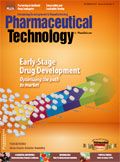A Troubleshooting Guide for Topical Drug Manufacturing
Consider critical process parameters and strategies to optimize the manufacturing process.
An ideal topical formulation can be produced using a simple, flexible process. Most topical formulations developed today, however, are complex and, therefore, require tightly controlled processing parameters. Following are five critical process parameters (CPPs) and additional strategies to optimize the manufacturing process for topical dosage forms.
Understand critical process parameters
Temperature. Processing at the right temperature is critical for successful manufacturing. Too much heating during processing can result in chemical degradation. Insufficient heat can lead to batch failures, and excess cooling can result in the precipitation of solubilized ingredients. An example of the need for good temperature control is the emulsification step of a traditional oil-in-water emulsion. If the temperature of the water phase is much cooler than that of the oil phase, the melted constituents of the oil phase may solidify upon introduction into the aqueous phase and never properly form the emulsion, possibly even resulting in solid matter in the batch.
Heating and cooling rates. Heating too slowly can result in poor yields from evaporative loss. Heating too rapidly may burn areas of the batch in contact with the heating surface, which raises the potential for burnt material in the batch. Rapid cooling can result in precipitation/crystallization or increased viscosity. The successful consistency of ointments, for example, depends on proper rates of heating and cooling.
Mixing methods and speeds. It is essential to determine the required amount of shear and the optimal mixing methods and speeds. Emulsification typically requires high shear or homogenization to obtain the optimal droplet size and dispersion, while the mixing of a gel may require low shear in order to preserve certain physical characteristics, such as viscosity. Proper mixing speeds must be obtained for each phase at every batch scale. Optimal hydration depends on the amount of shear imparted to initially disperse the polymer into the medium. If the process involves only very low shear mixing, a polymer may never be completely dispersed and hydrated, which may result in an out-of-specification viscosity. Equipment, such as a recirculation loop, may also be used to correct uniformity without changing mixing speed or time, as shown in Figure 1.

Figure 1: Diagram of mixer with recirculation loop. When top, middle, and bottom active uniformity samples differed by more than 15%, DPT added a recirculation loop during mixing. The loop produced a far more uniform product without increasing the speed or time of mixing. (FIGURE COURTESY OF THE AUTHOR)
Mixing times. Optimizing mixing time requires identifying the minimum time required for ingredients to dissolve and the maximum mixing time before product failure (e.g., when viscosity begins to drop). For polymeric gels, particularly acrylic acid-based types, over-mixing, especially high shear, can break down the polymer's structure. In an emulsion, over-mixing may cause the product to separate prematurely, resulting in a drastic decline in viscosity.
Flow rates. Optimizing flow rate involves determining the amount of shear or throughput needed. For example, a water-in-oil emulsion may require a slower addition speed than a traditional, oil-in-water emulsion, and the flow rate must be modified appropriately. Care must be taken for any product using a pump. Overshearing can occur if the formulation is pumped too quickly. If pumping is too slow, the formulation will experience extra time in an in-line homogenizer, thus also exposing the formulation to additional shear.
Two processes that require experimentation to optimize flow rates are the use of a powder eduction system and an in-line homogenizer. Theoretical calculations can determine the number of times a sample will pass through either, but actually performing the experiments is necessary to achieve optimal results.
Raw material dispersers and in-line homogenizers require proper flow rates for optimal usage. If the product is not flowing through a disperser at the proper rate, there will not be enough suction for properly incorporating the powders. Suction can be tested by measuring the vacuum being pulled at the inlet of the disperser with a vacuum/pressure gauge. Monitoring the flow rate when using an in-line homogenizer is necessary in order to calculate the theoretical number of times the product passes through it.
Incorporate QbD
Implementing a quality-by-design (QbD) approach to developing CPPs has become a necessity. Most notably, a design of experiments (DOE) can be used to gain an understanding of what processing parameters have the greatest impact on the critical quality attributes of the final product. This understanding can be used to implement a chemistry, manufacturing, and controls (CMC) strategy to ensure stability, product performance, and process control in manufacturing a topical drug product. A DOE, for example, was conducted to determine how the final viscosity of a formula varied based on the amount of shear and temperature during which the shear is applied. The goal was to produce the product with the highest viscosity. As shown in Table I, the higher rate of shear yielded the best results.

Table I: A design of experiments was conducted to determine how the final viscosity of a formula varied based on the amount of shear and temperature during which the shear is applied. Emulsification rate was held constant at high rpm.Emulsification temperature was held constant at 75â80 °C. Emulsification time and the rate of low-shear mixing were varied. The goal was to produce the highest product viscosity; the higher rate of shear yielded the best results.
Use process-control tools
Even though preserved, topical formulations do not require the strict process controls required in sterile manufacturing, topical formulations must still have a well understood and controlled process. Emulsions, for example, can be difficult to process because they are inherently thermodynamically unstable. The use of manufacturing vessels with programmable logic controllers (PLCs) is one tool that can provide more reliable and accurate control of the pressure/temperature and mixing speed and times.
Add ingredients in the optimal phase and order
Generally, topical formulations comprise one or more phases. Emulsions, for example, primarily comprise an aqueous phase and a hydrophobic phase. Adding ingredients in the correct phase contributes to overall stability. For example, some polymers, such as microcrystalline cellulose/sodium carboymethylcellulose, must be dispersed and hydrated prior to adding other ingredients.
Most ingredients have an optimal method of incorporation into a formulation. Preservatives, such as parabens, should be added just prior to emulsification to reduce time in contact with water-soluble surfactants at elevated temperatures. Polymers (e.g., carbomer) and gums (e.g., xanthan) must be added slowly to avoid formation of fish eyes and other partially hydrated, undispersed material. These problems can be avoided by using eductors (e.g., Tri-Blender and Quadro Ytron dispersers) or by preparing a slurry of polymer or gum in a medium of low or no solubility (e.g., glycerin or glycols for certain gums or oils for carbomers). These thickeners act as emulsion stabilizers to keep oils or creams suspended in water and prevent separation. Such thickeners can be shear sensitive, however, so they must be processed with care.
As an example, DPT Labs was tasked with manufacturing a formulation that was a fatty-acid-based emulsion neutralized using an amine. With the amine in the water phase upon emulsification, the product immediately gained viscosity, requiring a higher mixing speed. As the product cooled, the formulation hit a critical temperature in which it rapidly thinned out and began splashing out of the mixing tank. Resequencing the product and adding the amine post-emulsification, however, maintained the quality of the product and eliminated negative effects on the formulation and potential danger to staff.
Protect APIs from degradation
The manufacturing process must be designed to protect APIs from physical degradation. Some APIs, such as retinoic acid compounds, are sensitive to both ultraviolet (UV) light and oxygen. These APIs can be protected by using yellow or amber light that is free from harmful, low-wavelength UV rays and by using nitrogen, argon, or another inert gas to purge the product of oxygen.
Identify equipment constraints
The manufacturer must be able to perform all processes using its current equipment capabilities. The scale-up path for a 1:10 batch size from the pilot or clinical size to commercial level must exist with similar equipment. Guidance from FDA's Scale-Up and Postapproval Changes Semisolids (SUPAC-SS) Working Group provides the basis of comparison for the design and operating principles of equipment (1).
Consider regulatory requirements
Satisfying regulatory requirements for the scale-up or transfer of a process can be challenging. To scale up a process used for clinical batch manufacturing or transfer a commercial process to a new manufacturing site, the equipment must at least be of the same materials of construction and employ the same type of mixing, as defined in the SUPAC-SS guidance (1).
Using an outsourcing partner
The manufacturing process can influence a topical product's stability and performance. If a formulation is transferred to a contract manufacturer, changes in mixing speeds, temperature controls, and order of ingredient addition may be needed. Outsourcing formulation development and manufacturing to a contract development and manufacturing organization allows technology transfer, scale-up, and manufacturing to take place at one location, which ensures project continuity.
Michael Lowenborg is research and development manager at DPT Laboratories, 3300 Research Plaza, San Antonio, TX 78235, tel. 210.531.7125, Michael.lowenborg@dptlabs.com.
Reference
1. FDA, Nonsterile Semisolid Dosage Forms, Scale-Up and Postapproval Changes: Chemistry, Manufacturing, and Controls; In Vitro Release Testing and In Vivo Bioequivalence Documentation (Rockville, MD, May 1997).

Drug Solutions Podcast: A Closer Look at mRNA in Oncology and Vaccines
April 30th 2024In this episode fo the Drug Solutions Podcast, etherna’s vice-president of Technology and Innovation, Stefaan De Koker, discusses the merits and challenges of using mRNA as the foundation for therapeutics in oncology as well as for vaccines.